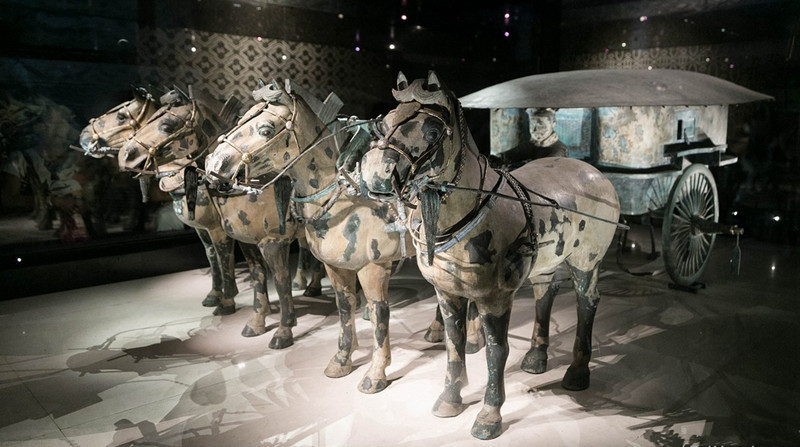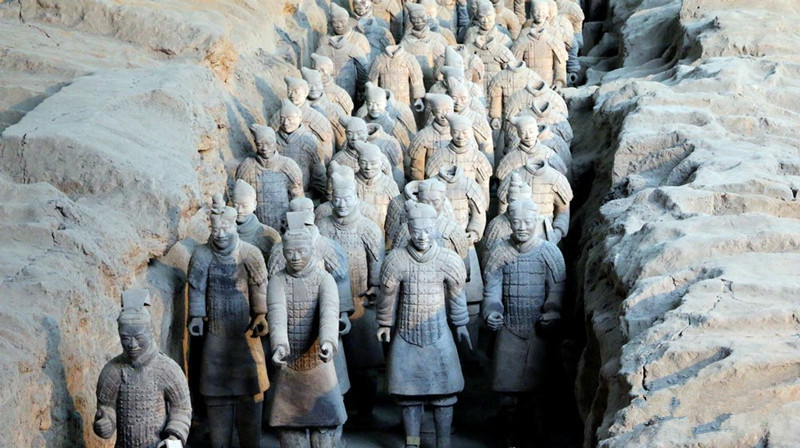
Qin Shi Huang Mausoleum (Mausoleum of the First Qin Emperor) in Xian

Qin Shi Huang Mausoleum Facts
The Qin Shi Huang Mausoleum is located in Lintong District, Xi'an, Shaanxi province of China. This mausoleum was constructed over 38 years, from 246 to 208 BC, and is situated underneath a 76-meter-tall tomb mound shaped like a truncated pyramid. The layout of the mausoleum is modeled on the Qin capital Xianyang, divided into inner and outer cities. The main tomb chamber housing the coffin and burial artifacts is the core of the architectural complex of the mausoleum.
Chinese Name: 秦始皇陵
Type: Culture & Mausoleums; Imperial Mausoleum
Address: 5 km from northern foot of Mount Li, east of Lintong District, Xian, Shaanxi Province, China.
Best Seasons: All year round
Recommended Visiting Time: about 1-2 hours
Opening Hours: 8:30-17:00
Ticket: CNY 120
Why is Emperor Qin Shi Huang Mausoleum So Special?
- Integrity
The Qinshihuang Mausoleum features a high level of integrity; the grave mound, mausoleum constructions, burial pits, sites of ritual construction and overall setting in the property area and the buffer zone are well preserved, and fully reflect the structure and ritual system of the whole mausoleum. - Authenticity
The grave mound, sites of constructions, burial tombs and burial pits in Qinshihuang Mausoleum truthfully maintain their original location, material, formation,technology and structure, which authentically reflect the constricting regulation of the Mausoleum and palace life and military systems of the Qin Dynasty. The numerous unearthed cultural relics reflect the highest technical level of pottery, chariot assembly, metallurgy and metal processing in the Qin Dynasty. - Qinshihuang was a great emperor. Standing before the massive underground army, you will feel the extraordinary might of the Qin Emperor that enabled him to unify six warring states two thousand years ago.
Where is The Qin Shi Huang Mausoleum?
Located at the northern foot of Lishan Mountain, 35 kilometers northeast of Xi’an, Shaanxi Province, Qinshihuang Mausoleum is the tomb of Emperor Qinshihuang, founder of the first unified empire in Chinese history during the 3rd century BCE. Begun in 246 BCE the grave mound survives to a height of 51.3 meters within a rectangular, double-walled enclosure oriented north-south. Nearly 200 accompanying pits containing thousands of life-size terra cotta soldiers, terra cotta horses and bronze chariots and weapons – a world-renowned discovery – together with burial tombs and architectural remains total over 600 sites within the property area of 56.25 square kilometers. According to the historian Sima Qian (c. 145-95 BCE), workers from every province of the Empire toiled unceasingly until the death of the Emperor in 210 in order to construct a subterranean city within a gigantic mound.
 The First Emperor of Imperial China — Qinshihuang
The First Emperor of Imperial China — Qinshihuang
Qin Shi Huangdi (259 BC – 210 BC), the first emperor of China, ascended the throne at the age of 13, when construction of his tomb began. On completion of his many conquests, he ordered 720,000 conscript laborers to hurry up on building his royal tomb. It was finished just-in-time in 210 BC for his use. His son, the second Qin Emperor,saw his entombment.
Qin Shi Huang ( 秦始皇) was born Ying Zheng (嬴政) or Zhao Zheng (趙政), a prince of the state of Qin. He became Zheng, the King of Qin (秦王政) when he was thirteen, then China’s first emperor when he was 38 after the Qin had conquered all of the other Warring States and unified all of China in 221 BC. Rather than maintain the title of “king” (王) borne by the previous Shang and Zhou rulers, he ruled as the First Emperor (始皇帝) of the Qin dynasty from 221 BC to 210 BC. His self-invented title “emperor” (皇帝), as indicated by his use of the word “First”, would continue to be borne by Chinese rulers for the next two millennia.
History of Qin Shi Huang Mausoleum
The Qin Terracotta Warriors and Horses are world famous, attracting a large number of tourists from home and abroad to visit each year. However, they are only a part of the yet unexcavated mausoleum of Emperor Qin Shi Huang located to its west. Inside it, greater things are yet to come.
Buried deep under a hill in central China, surrounded by an underground moat, an emperor has lain undisturbed for more than two millennia. He is China’s first emperor, Qin Shi Huang, who died in 210 B.C. after conquering six warring states to create the first unified nation of China. Wanting protection in the afterlife, Emperor Qin created an army of 8,000 soldiers, 130 chariots with 520 horses, and 150 cavalry horses made of terracotta.
In 1974, some farmers happened to dig up what turned out to be a large-scale pit with terracotta soldiers and horses, belonging to the Emperor Qin. After 2,200 years, the Emperor’s tremendous army stood as though living again. The life-size terracotta solider they dug out of the ground turned out to be just one of an army of thousands, each utterly unique, with individual clothing, hair and facial features.
 Best Time to Go to Qin Shi Huang Mausoleum
Best Time to Go to Qin Shi Huang Mausoleum
All year round. The peak season of traveling to Xi’an is in the spring and autumn. In summer the temperature is high with strong ultraviolet ray. It is easy to cause heat stroke under the blazing sun for quite a long time in outdoor, and sometimes it will rain, so tourists should watch the weather forecast in advance before visiting. What’s more, tourists need to put on sunscreen and try to avoid ultraviolet rays during the day time travel; Winter temperature is low, the wind is piercingly cold, only suitable for indoor attractions visiting.
Main Attractions of Qin Shi Huang Mausoleum
City Wall
Grave Mound
Palace Wall
It was verified that the palace wall is about 168 meters long, from north to south is 141 meters, the south wall is 16 meters wide, 22 meters wide at the north wall. Wall is done with multilayer fine soil compaction, and each layer is about 5 ~ 6 cm thick, very delicate and strong. In the process while built, in order to detect whether the soil compaction of wall was hard, construction personnel will stand at a distance with bows and arrows shot wall, the constructors would shoot arrow and if the arrow could be plugged into the wall then the wall must be torn down.
Underground Palace
Below the grave mound is underground palace which is square. Underground palace is the center of all buildings of The Mausoleum of Emperor Qin Shi Huang. According to archaeological discovery, the underground palace has area of about 180000 square meters, center depth of about 30 meters. Underground palace is placed in coffin and implements buried with emperor, it is the core of the Qin tomb construction.
 How to get to Qin Shi Huang Mausoleum
How to get to Qin Shi Huang Mausoleum
Travel with ChinaDragonTours (top recommended)
If you want to get out of the traffic and hassle of navigation, you can book a private tour package that includes visiting, dining and transfer from us. Our local guide and driver will escort you to the Qin Shi Huang Mausoleum in Xi’an in the fastest and most convenient way and take care of all the details. You just have to focus on the visiting.
Independent Traveler
- From Xi’an:
Take tourism bus no. 5 (306) from east square of Xi’an Railway Station and get off at Bing Ma Yong (Terracotta Army Museum) stop. The whole journey takes one hour, and the fare is CNY7.
Take bus 307, which departs from Tangchengqiang Jiuqu Hub, and passes Tang Paradise and Big Wild Goose Pagoda. The whole line takes 2.5 hours and costs CNY 8. - From Lintong:
Take bus no.101 to Qinling Station.
Useful Travel Tips
- Around the mausoleum, there are many accompanying tombs scattered over a 56 square km tomb area. In addition to the discovered vaults seen in the famous museum of the Terracotta Warriors and Bronze Horses, some more vaults have been discovered recently that contain other artifacts. As time goes by, archeologists are sure to discover more treasures.
- Getting Around:
Battery-powered motor vehicles and ancient-style carriage are available for visitors to tour around the mausoleum;
30 free shuttle buses are traveling between the Qin Shi Huang Mausoleum and the Museum of Qin Terracotta Warriors and Horses for tourists’ convenience. One can take them by showing the entrance ticket. - Admission Fee: CNY 120
free for children under 1.4 m (4.6 ft); children taller than 1.4m and under age 16 can enjoy half-price tickets; foreign students studying in China with valid student ID can enjoy half-price tickets.
The fare is for the Emperor Qinshihuang’s Mausoleum Site Museum Through Ticket including the Museum of Qin Terracotta Warriors and Horses, Lishan Garden and shuttle buses inside the scenic area.
Note: Foreigners’ passports will be required when booking tickets and entering the museum. - Main highlight of interest: The mound itself and the garden is the highlight; there is a model tomb mock-up that tourists ignore.
- Suited to: People who are really interested in his life or the Qin era. Otherwise, it will just be a hill to look at.
Nearby Attractions
- Giant Wild Goose Pagoda
- Small Wild Goose Pagoda
- Tang Paradise
- Terra-Cotta Warriors
- Da Ci’en Temple
- Qinshihuang’s Mausoleum Site Museum
- Zhaoling Mausoleum
- South Wutai Mountain
- Caotang Temple in Huxian
- Xiangji Temple in Xian
- Xianyou Temple Museum
- Xingjiao Temple
- Taiping National Forest Park
- Zhuque National Forest Park
 The First Emperor of Imperial China — Qinshihuang
The First Emperor of Imperial China — Qinshihuang Best Time to Go to Qin Shi Huang Mausoleum
Best Time to Go to Qin Shi Huang Mausoleum How to get to Qin Shi Huang Mausoleum
How to get to Qin Shi Huang Mausoleum













